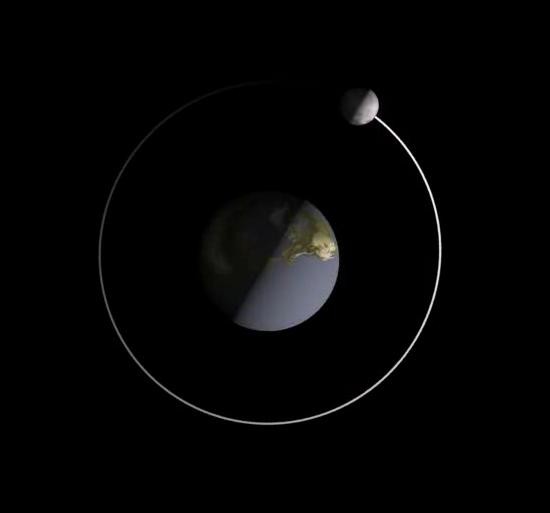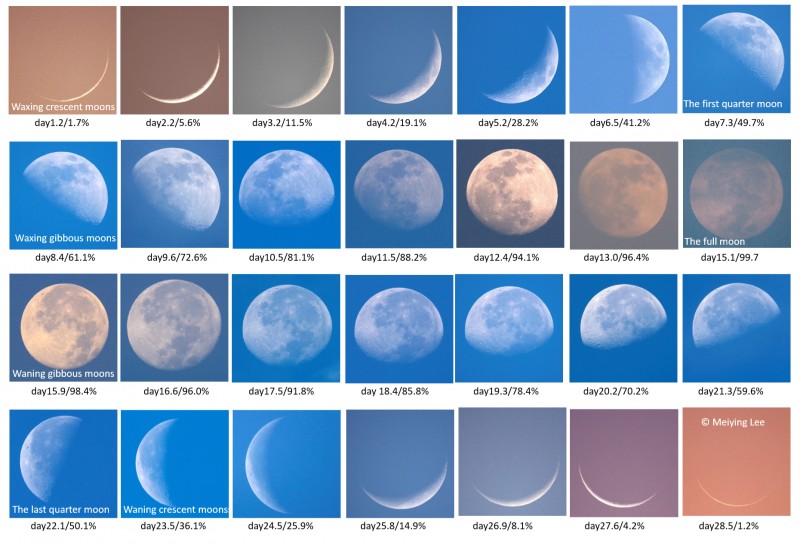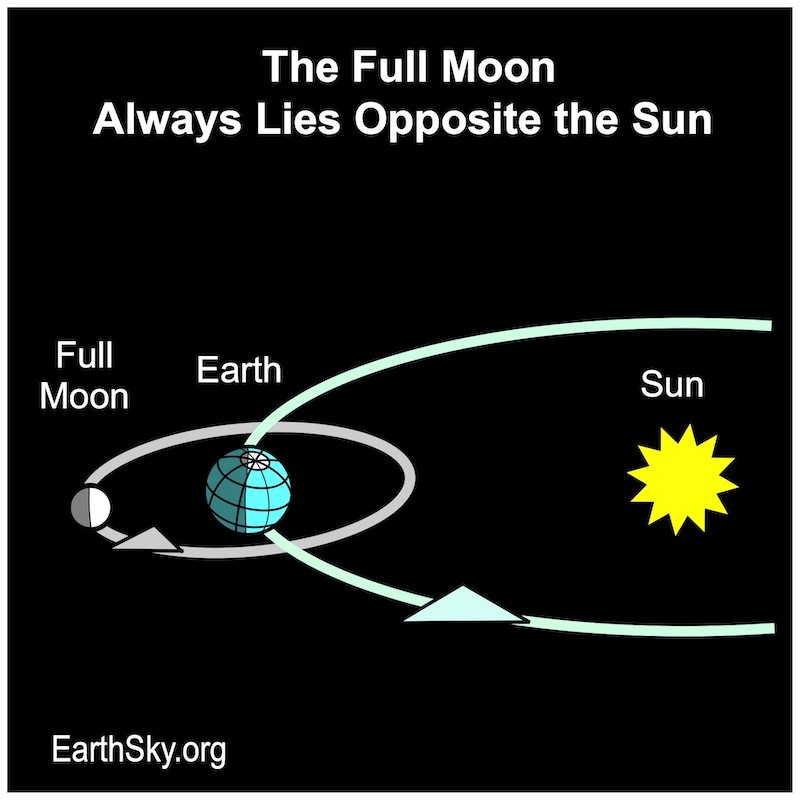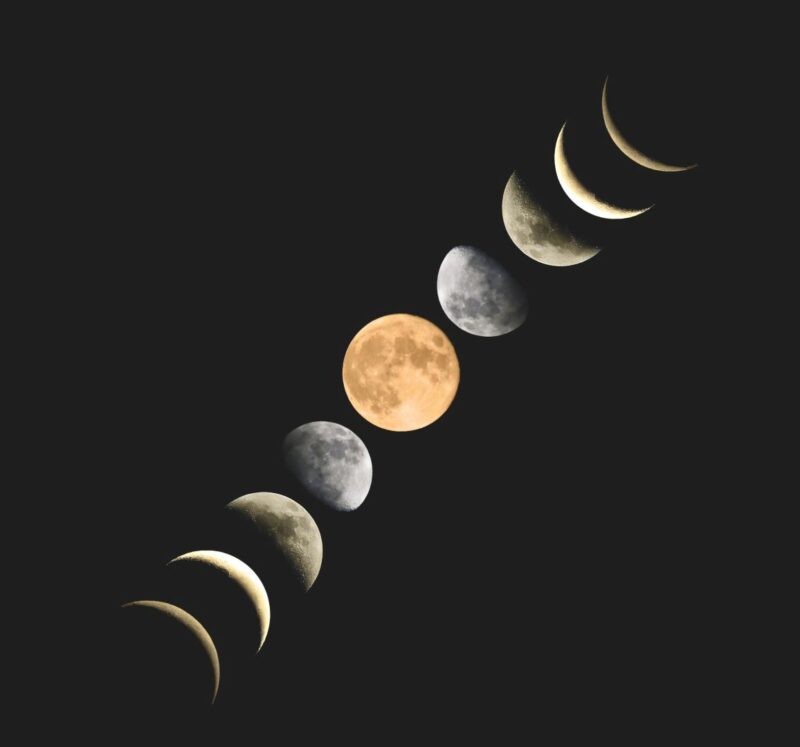The question “Does The Moon Travel East To West” often arises when observing the night sky, and TRAVELS.EDU.VN is here to clarify this fascinating celestial phenomenon. While it appears to move from east to west across the sky each night, similar to the sun, the moon’s overall orbital motion is actually eastward. This apparent westward movement is due to Earth’s rotation. Understanding this complex motion involves considering the moon’s orbit, Earth’s rotation, and the interplay between these two movements, enhancing your appreciation for astronomy and related topics.
1. The Moon’s Daily Rise and Set: An Illusion?
Just like the sun and stars, the moon rises in the east and sets in the west each day. This daily east-to-west movement is primarily caused by Earth’s rotation on its axis. Our planet spins eastward, making celestial objects appear to move westward across the sky. This daily motion is what creates the illusion that the moon is traveling from east to west.
 Moon phases: Top view of half-lit Earth and half-lit moon with lines between dark and light sides aligned.
Moon phases: Top view of half-lit Earth and half-lit moon with lines between dark and light sides aligned.
2. The Moon’s True Orbital Direction: Eastward Bound
While the moon appears to move westward daily, its actual orbital motion around Earth is eastward. This means that over a longer period, such as a month, the moon gradually shifts its position eastward relative to the background stars. Think of it like walking on a moving treadmill – you are walking forward (eastward in the moon’s case), but relative to someone standing still, you appear to be moving backward (westward) due to the treadmill’s motion (Earth’s rotation).
3. Lunar Orbit and Its Impact on Moonrise Times
The moon takes approximately 27.3 days to complete one orbit around Earth (sidereal period). During this time, it moves about 13 degrees eastward in the sky each day. This eastward movement causes the moon to rise about 50 minutes later each day, on average. This is because Earth has to rotate a little further each day to “catch up” with the moon’s new position in its orbit.
4. Why We See Different Moon Phases: The Sun’s Role
The phases of the moon – new moon, crescent, quarter, gibbous, and full moon – are determined by the relative positions of the sun, Earth, and moon. The moon itself doesn’t emit light; it reflects sunlight. As the moon orbits Earth, we see different amounts of its sunlit surface, resulting in the familiar phases.
- New Moon: The moon is between Earth and the sun, and its sunlit side faces away from us. We cannot see the moon.
- Full Moon: Earth is between the sun and the moon, and the moon’s entire sunlit side faces us. We see a fully illuminated moon.
- First Quarter & Last Quarter: The moon is at a 90-degree angle to the sun, and we see half of its sunlit side.
Understanding moon phases enriches your stargazing experience and provides a deeper understanding of celestial mechanics.
 28-panel composite with a moon in each panel varying in phase through a lunar cycle.
28-panel composite with a moon in each panel varying in phase through a lunar cycle.
5. Observing the Moon’s Motion: A Practical Guide
To observe the moon’s motion, try the following:
- Choose a Landmark: Select a fixed object, such as a tall building or a tree, to use as a reference point.
- Observe Over Several Hours: Note the moon’s position relative to your landmark at regular intervals (e.g., every hour). You will notice it gradually moving westward due to Earth’s rotation.
- Track Over Several Days: Observe the moon at the same time each night for several days. You will notice it shifting eastward relative to the stars.
6. The Moon’s Apparent Westward Movement: A Closer Look
The apparent westward movement of the moon is a consequence of Earth’s rotation. As our planet spins eastward, celestial objects appear to rise in the east and set in the west. This is the same reason why the sun appears to move across the sky each day.
Think of it this way: Imagine you are standing on a merry-go-round that is spinning counterclockwise. If you look out at a fixed object in the distance, it will appear to move clockwise (opposite to the direction of the merry-go-round’s spin). Similarly, Earth’s eastward rotation makes the moon appear to move westward.
7. The Moon’s Eastward Orbital Motion: Unveiling the Truth
While the daily westward motion is apparent, the moon’s actual orbital motion is eastward. This means that over a longer period, the moon gradually shifts its position eastward relative to the background stars.
To understand this, consider the moon’s position relative to a specific star on two consecutive nights. On the first night, note which star is closest to the moon. On the second night, you will notice that the moon has moved slightly eastward, away from that star and closer to another star further east.
8. Sidereal vs. Synodic Month: Understanding Lunar Cycles
There are two primary ways to measure the moon’s orbital period:
- Sidereal Month: The time it takes for the moon to complete one orbit around Earth relative to the fixed stars (approximately 27.3 days).
- Synodic Month: The time it takes for the moon to complete one cycle of phases (e.g., from new moon to new moon, approximately 29.5 days).
The synodic month is longer than the sidereal month because Earth is also orbiting the sun. As the moon orbits Earth, Earth is also moving around the sun, so the moon has to travel a little further to reach the same phase again.
9. Lunar Libration: The Moon’s Wobble
The moon’s orbit around Earth is not perfectly circular; it is slightly elliptical. This means that the moon’s speed varies slightly as it orbits Earth. When the moon is closer to Earth, it moves faster, and when it is further away, it moves slower.
This variation in speed, combined with the fact that the moon’s axis of rotation is tilted slightly relative to its orbital plane, causes the moon to appear to wobble slightly as it orbits Earth. This wobble is called lunar libration.
Lunar libration allows us to see slightly more than half of the moon’s surface over time. In total, we can observe about 59% of the moon’s surface due to libration.
10. Tides and the Moon: A Gravitational Dance
The moon’s gravitational pull is the primary cause of tides on Earth. The moon’s gravity pulls on the water on Earth’s surface, creating a bulge on the side of Earth facing the moon. A similar bulge also occurs on the opposite side of Earth due to inertia.
As Earth rotates, different locations pass through these bulges, experiencing high tides. Low tides occur in the areas between the bulges.
The sun also exerts a gravitational pull on Earth, but its effect is smaller than the moon’s because the sun is much further away. When the sun and moon are aligned (during new moon and full moon), their combined gravitational pull creates higher-than-usual tides, called spring tides. When the sun and moon are at right angles to each other (during first quarter and last quarter), their gravitational pulls partially cancel each other out, creating lower-than-usual tides, called neap tides.
 Chart showing new moon between Earth and the sun.
Chart showing new moon between Earth and the sun.
11. Eclipses: When Earth, Sun, and Moon Align
Eclipses occur when the sun, Earth, and moon align in a straight line. There are two types of eclipses:
- Solar Eclipse: The moon passes between the sun and Earth, blocking the sun’s light.
- Lunar Eclipse: Earth passes between the sun and the moon, casting a shadow on the moon.
Solar eclipses are relatively rare because the moon’s orbit is tilted slightly relative to Earth’s orbit around the sun. This means that the moon usually passes above or below the sun in the sky. Lunar eclipses are more common because Earth’s shadow is much larger than the moon.
12. Exploring Napa Valley Under the Moonlight: A TRAVELS.EDU.VN Experience
Imagine experiencing the breathtaking beauty of Napa Valley under the soft glow of the moon. TRAVELS.EDU.VN offers unique nighttime tours that allow you to explore the vineyards and rolling hills in a completely new light.
Here’s what you can expect:
- Stargazing Tours: Our expert guides will lead you on a journey through the night sky, pointing out constellations, planets, and other celestial wonders.
- Moonlit Vineyard Walks: Stroll through the vineyards under the moonlight, learning about the unique terroir and the winemaking process.
- Wine Tasting Under the Stars: Indulge in a selection of Napa Valley’s finest wines while enjoying the serene ambiance of the night.
- Romantic Getaways: Create unforgettable memories with a romantic moonlit getaway in Napa Valley.
13. Napa Valley’s Unique Terroir and Lunar Influence
Some believe that the moon’s phases and gravitational pull can influence the growth of vines and the quality of wine. While scientific evidence is limited, many winemakers in Napa Valley follow lunar cycles when planting, pruning, and harvesting their grapes.
For example, some winemakers believe that planting during the waxing moon (the period between new moon and full moon) promotes vegetative growth, while planting during the waning moon (the period between full moon and new moon) encourages root development. Similarly, they may harvest grapes during specific lunar phases to optimize the flavor and aroma of the wine.
Whether or not these beliefs are scientifically proven, they add a unique dimension to the winemaking process in Napa Valley, and contribute to the region’s rich cultural heritage.
14. Enhancing Your Napa Valley Experience with TRAVELS.EDU.VN
Planning a trip to Napa Valley can be overwhelming, but TRAVELS.EDU.VN is here to make it easy. We offer a wide range of services to help you create the perfect Napa Valley experience, including:
- Customized Itineraries: We will work with you to create a personalized itinerary based on your interests, budget, and time constraints.
- Hotel Reservations: We have partnerships with a variety of hotels in Napa Valley, from luxurious resorts to charming bed and breakfasts.
- Wine Tour Bookings: We can book wine tours at some of Napa Valley’s most prestigious wineries.
- Transportation: We can arrange transportation for you, including airport transfers, private car services, and shuttle buses.
- Restaurant Reservations: We can make reservations for you at some of Napa Valley’s finest restaurants.
With TRAVELS.EDU.VN, you can relax and enjoy your Napa Valley vacation without having to worry about the details.
 Diagram: Moon, Earth, and sun in alignment with moon on far side of Earth from the sun.
Diagram: Moon, Earth, and sun in alignment with moon on far side of Earth from the sun.
15. Why Choose TRAVELS.EDU.VN for Your Napa Valley Trip?
TRAVELS.EDU.VN offers several advantages over other travel agencies:
- Local Expertise: We are based in Napa Valley and have extensive knowledge of the region.
- Personalized Service: We provide personalized service and attention to detail.
- Competitive Pricing: We offer competitive pricing on all of our services.
- Convenience: We handle all of the details of your trip, so you can relax and enjoy your vacation.
- 24/7 Support: We offer 24/7 support in case you need assistance during your trip.
Here’s a glimpse of what TRAVELS.EDU.VN can offer:
| Tour Type | Description | Price (USD) |
|---|---|---|
| Daytime Wine Tour | Visit 3-4 wineries, enjoy tastings, and learn about the winemaking process. | $150 – $250 |
| Moonlit Vineyard Walk | Experience the vineyards under the stars, learn about the terroir, and enjoy a glass of wine. | $75 – $125 |
| Stargazing Tour | Explore the night sky with an expert guide, learn about constellations and planets, and enjoy breathtaking views. | $100 – $175 |
| Romantic Getaway | Enjoy a luxurious stay at a Napa Valley resort, indulge in wine tastings, and create unforgettable memories with your loved one. | $500+ |
16. Customer Testimonials: Hear From Satisfied TRAVELS.EDU.VN Clients
“TRAVELS.EDU.VN made our Napa Valley trip unforgettable. The personalized itinerary, luxurious accommodations, and expert wine tour guides exceeded our expectations. We highly recommend their services” – John & Mary, Los Angeles, CA.
“From start to finish, TRAVELS.EDU.VN took care of every detail. The moonlit vineyard walk was a magical experience, and the wine tasting under the stars was simply divine. We can’t wait to return” – Sarah & David, New York, NY.
17. Planning Your Moonlit Escape: A Step-by-Step Guide with TRAVELS.EDU.VN
- Contact TRAVELS.EDU.VN: Reach out to our team via WhatsApp at +1 (707) 257-5400 or visit our website at TRAVELS.EDU.VN.
- Discuss Your Preferences: Share your interests, budget, and desired travel dates.
- Receive a Customized Itinerary: We’ll create a personalized itinerary tailored to your needs.
- Confirm Your Bookings: Review and confirm your hotel reservations, wine tour bookings, and transportation arrangements.
- Enjoy Your Napa Valley Adventure: Relax and let us handle the details while you create unforgettable memories.
18. Understanding the Science Behind Napa Valley’s Beauty
Napa Valley’s unique climate and geography, combined with the skill and dedication of its winemakers, contribute to the region’s reputation for producing world-class wines. The valley’s warm days and cool nights, along with its diverse soil types, create the perfect conditions for growing a variety of grape varietals.
The moon, with its gravitational pull and influence on tides, may also play a role in the growth of vines and the quality of wine. While scientific evidence is limited, the belief in lunar influence adds a unique dimension to the winemaking process in Napa Valley.
19. Napa Valley by the Numbers: Key Statistics and Insights
- Annual Visitors: Napa Valley attracts over 3.85 million visitors each year (Source: Visit Napa Valley).
- Wineries: There are over 400 wineries in Napa Valley (Source: Napa Valley Vintners).
- Grape Varietals: Cabernet Sauvignon is the most widely planted grape varietal in Napa Valley, followed by Chardonnay, Merlot, and Pinot Noir (Source: Napa Valley Grapegrowers).
- Economic Impact: The wine industry contributes over $50 billion annually to the California economy (Source: Wine Institute).
- Average Rainfall: Napa Valley receives an average of 24 inches of rainfall per year (Source: Western Regional Climate Center).
 Phases of the moon, from new to full to new again lined up in a diagonal row. The full moon is orange. The rest are grey.
Phases of the moon, from new to full to new again lined up in a diagonal row. The full moon is orange. The rest are grey.
20. Frequently Asked Questions About the Moon and Napa Valley
Q1: Does the moon travel east to west?
- While it appears to move from east to west daily due to Earth’s rotation, the moon’s actual orbital motion is eastward.
Q2: How does the moon influence tides in Napa Valley?
- Napa Valley is inland, so the moon’s influence on tides is not directly visible. However, the moon’s gravitational pull affects the entire planet, including the region’s climate.
Q3: Do winemakers in Napa Valley follow lunar cycles?
- Some winemakers believe that lunar cycles can influence the growth of vines and the quality of wine, and they may follow lunar calendars when planting, pruning, and harvesting.
Q4: What are the best times to visit Napa Valley for moonlit experiences?
- The full moon provides the most dramatic moonlight, but any clear night can offer a magical experience.
Q5: What types of moonlit tours does TRAVELS.EDU.VN offer?
- We offer stargazing tours, moonlit vineyard walks, wine tasting under the stars, and romantic getaways.
Q6: How can I book a moonlit tour with TRAVELS.EDU.VN?
- You can contact us via WhatsApp at +1 (707) 257-5400 or visit our website at TRAVELS.EDU.VN.
Q7: What is the address of TRAVELS.EDU.VN?
- Our address is 123 Main St, Napa, CA 94559, United States.
Q8: Does TRAVELS.EDU.VN offer customized itineraries?
- Yes, we can create personalized itineraries based on your interests, budget, and time constraints.
Q9: Are there any discounts available for TRAVELS.EDU.VN tours?
- Please contact us directly to inquire about any available discounts or special offers.
Q10: What is the best way to experience Napa Valley under the moonlight?
- Join a guided tour with TRAVELS.EDU.VN to learn about the night sky, explore the vineyards, and indulge in wine tasting under the stars.
Ready to Explore Napa Valley Under the Stars?
Don’t miss the opportunity to experience the magic of Napa Valley under the moonlight. Contact TRAVELS.EDU.VN today to plan your unforgettable adventure!
Address: 123 Main St, Napa, CA 94559, United States
WhatsApp: +1 (707) 257-5400
Website: TRAVELS.EDU.VN
Let travels.edu.vn be your guide to a celestial escape in the heart of wine country. Our local expertise and personalized service guarantee an experience that is as enchanting as the moonlit sky above Napa Valley. Contact us now to start planning your dream getaway, and prepare to be captivated by the beauty and romance of this extraordinary destination.